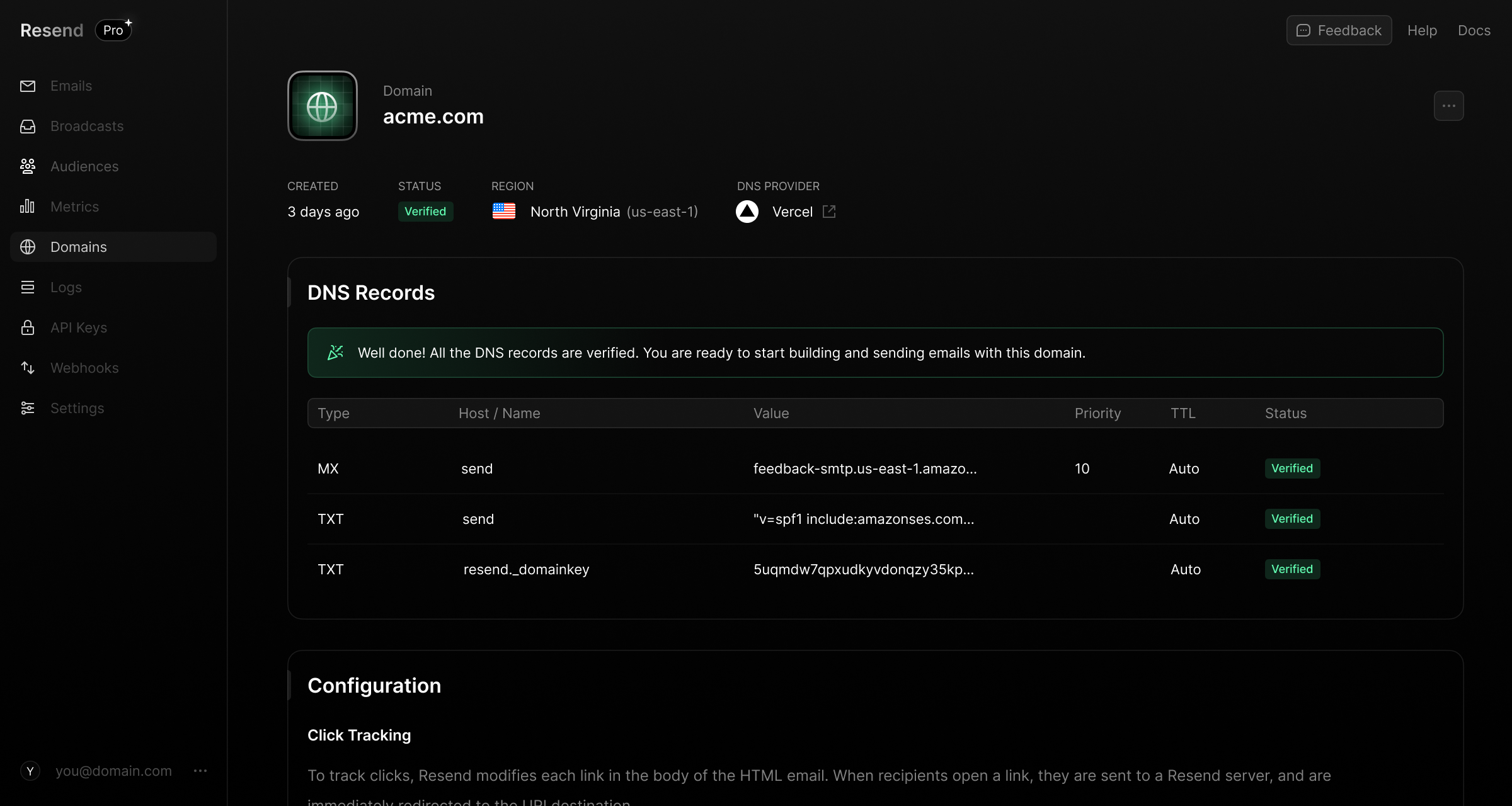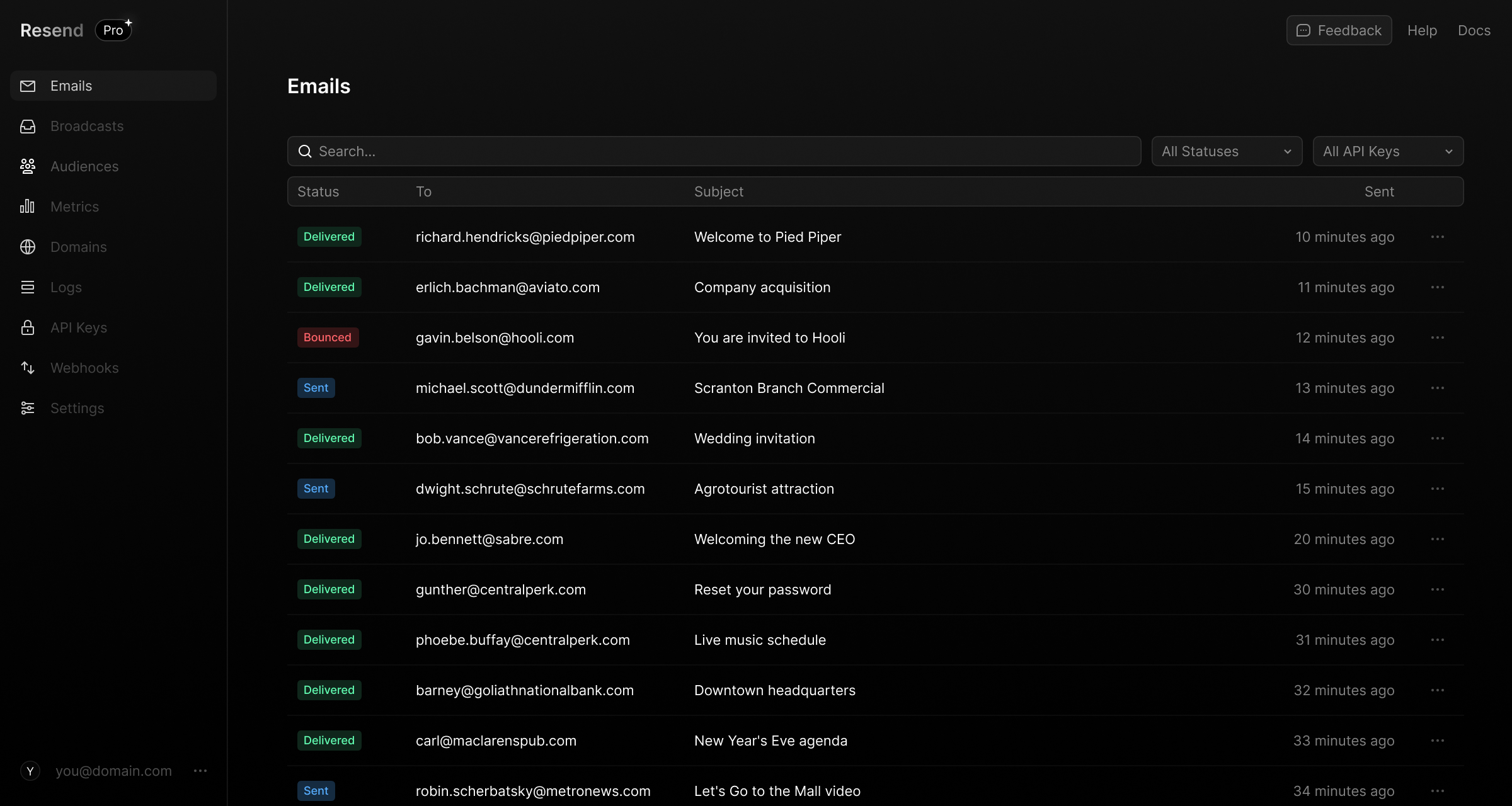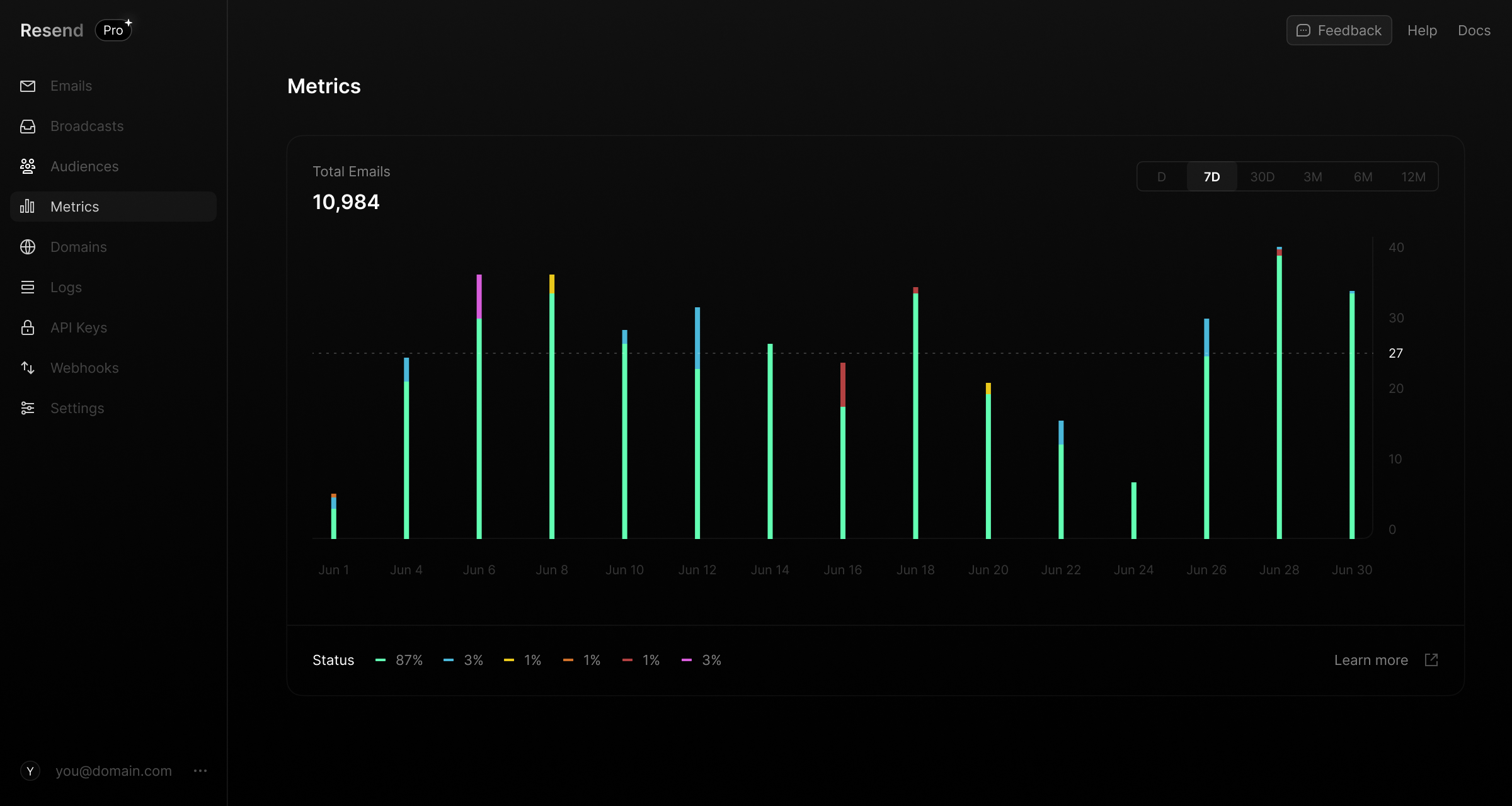
Migrating from
Postmark to Resend
Introduction
If you're considering migrating from Postmark to Resend, you're in the right place.
This guide will help you understand the key differences between the two services and provide you with the necessary steps to make the transition as smooth as possible.
Jump ahead
- History
- Concepts
- Official SDKs
- Send email via API
- Send email via SMTP
- Webhooks
- Security & Privacy
- Idempotency Keys
- Additional Features
- Pricing
- Conclusion
History
Postmark and Resend are both email delivery services, but they have different histories and focuses.
Key differences
- Postmark was founded in 2009. In May 2020, ActiveCampaign acquired Postmark.
- Resend was founded in 2023. Resend has a focus on providing a modern developer experience.
Concepts
Both Postmark and Resend provide user-friendly dashboards for managing your email sending.
Sender Signatures
In Postmark you need a confirmed Sender Signature or Verified Domain for each email address you want to send from.
Resend has the concept of Domains which allows you to send from any address under that domain.

Both Postmark and Resend offer similar authentication features.
| Name | Postmark | Resend |
|---|---|---|
| DKIM | DKIM enforced | DKIM enforced |
| SPF | SPF optional | SPF enforced |
| DMARC | DMARC recommended | DMARC recommended |
Servers
When you log into Postmark you are placed in the Servers page. These Servers let you separate your transactional, broadcasts, and inbound message streams.
When you log in to Resend, you are taken straight to the Emails page. This page allows you to see all emails sent without needing to set up a server first.

Message Streams
Postmark separates email traffic through Message Streams, meaning transactional and broadcast traffic never intersect.
Resend does not have this concept, and all emails are sent through the same stream.
Once you send emails, you can view their aggregated statuses in the Metrics page.

Official SDKs
Both Postmark and Resend provide official SDKs for various programming languages, making it easy to integrate into your application.
Key differences
- Postmark does not have official SDKs for Python, Go, or Rust (see docs).
| Platform | Postmark | Resend |
|---|---|---|
| Node.js | postmark.js | resend-node |
| PHP | postmark-php | resend-php |
| Python | - | resend-python |
| Ruby | postmark-gem | resend-ruby |
| Go | - | resend-go |
| Rust | - | resend-rust |
| Java | postmark-java | resend-java |
| .NET | postmark-dotnet | resend-dotnet |
Send email via API
Both Postmark and Resend provide a REST API and SDKs for sending emails programmatically.
Key differences
Authentication
- Postmark uses a custom header (
X-Postmark-Server-Token) to authenticate (see docs). - Resend uses a standard header (
Authorization: Bearer) to authenticate requests (see docs).
Rate limiting
- Postmark throws an error when rate limit is exceeded, but doesn't provide more details (see docs).
- Resend has response headers describing your current rate limit following every request in conformance with the IETF standard (see docs).
Logging
- Postmark's API only returns an HTTP response. There are no logs of API requests.
- Resend stores a history of API request logs, allowing for easy debugging of API responses and error codes (see docs).
Postmark
const postmark = require('postmark');var serverToken = "server-token";var client = new postmark.ServerClient(serverToken);client.sendEmail({"From": "sender@example.com","To": "receiver@example.com","Subject": "hello world","TextBody": "<p>it works!</p>"});
Resend
import { Resend } from 'resend';const resend = new Resend('re_xxxxxxxxx');await resend.emails.send({from: 'Acme <onboarding@resend.dev>',to: ['delivered@resend.dev'],subject: 'hello world',html: '<p>it works!</p>',});
Send email via SMTP
Both Postmark and Resend support sending emails via SMTP.
SMTP stands for Simple Mail Transfer Protocol. It is a text-based protocol in which one server communicates with another to send an email.
Key differences
Authentication
- Postmark uses the API Token for both Username and Password (see docs).
- Resend uses a standard value for the Username and the API Key as the Password (see docs).
Configurations
- Postmark does not support port 465 (see docs).
- Postmark supports adding custom metadata via headers (see docs).
| Configuration | Postmark | Resend |
|---|---|---|
| Host | `smtp-broadcasts.postmarkapp.com` or `smtp.postmarkapp.com` | `smtp.resend.com` |
| Port | 25, 587, or 2525 | 25, 465, 587, 2465, or 2587 |
| Username | Postmark Server API Token or Access Key | The '`resend`' string |
| Password | Postmark Server API Token or Secret Key | Resend API key |
| Authentication | Plain text (unencrypted), CRAM-MD5, TLS | SMTPS or STARTTLS |
Webhooks
Both Postmark and Resend provide webhooks to notify your application of email events.
Key differences
- Postmark does not have support for email sent and delivery delay events (see docs).
- Resend has logs of webhook requests, allowing you to see the status of your webhook responses (see docs).
| Event | Postmark | Resend |
|---|---|---|
| Inbound | Inbound | Inbound |
| Send | - | email.sent |
| Delivery | Delivery | email.delivered |
| Delivery Delayed | - | email.delivery_delayed |
| Bounces | Bounce | email.bounced |
| Complaints | Spam Complaint | email.complained |
| Open Tracking | Open | email.opened |
| Click Tracking | Click | email.clicked |
| Unsubscribe | Subscription Change | contact.updated |
Security & Privacy
Postmark and Resend have robust security features, but some major differences exist.
Key differences
- Postmark is not SOC 2 compliant, while Resend is (see more).
- Postmark does not enforce SPF, while Resend does (see docs).
| Name | Postmark | Resend |
|---|---|---|
| Authentication | Email/Password | Email/Password, Google, GitHub |
| Multi-Factor Auth | MFA available | MFA available |
| GDPR | GDPR compliant | GDPR compliant |
| SOC 2 | - | SOC 2 compliant |
Idempotency Keys
Resend supports idempotency keys on the POST /emails and POST /emails/batch endpoints.
Postmark does not currently support idempotency keys.
An idempotent operation is an action you can perform more than once, with the same input, and it always produces the same outcome and avoids repeating side effects.
By adding an Idempotency-Key header, or using the equivalent field on our SDKs, you can tell Resend that this specific email should only be sent once, even if we get more than one request from you about it.
POST /emails
await resend.emails.send({from: 'Acme <onboarding@resend.dev>',to: ['delivered@resend.dev'],subject: 'hello world',html: '<p>it works!</p>',},{idempotencyKey: 'welcome-user/123456789',},);
POST /emails/batch
import { Resend } from 'resend';const resend = new Resend('re_xxxxxxxxx');await resend.batch.send([{from: 'Acme <onboarding@resend.dev>',to: ['foo@gmail.com'],subject: 'hello world',html: '<h1>it works!</h1>',},{from: 'Acme <onboarding@resend.dev>',to: ['bar@outlook.com'],subject: 'world hello',html: '<p>it works!</p>',},],{idempotencyKey: 'team-quota/123456789',},);
Adding idempotency keys not only helps you avoid sending duplicate emails and using up your quota, but also enables building more robust and scalable systems.

Idempotency Keys
Learn how to send an idempotent email using Resend.
https://resend.com/docs/dashboard/emails/idempotency-keys
Additional Features
Outside of core email sending, Resend offers additional features that Postmark does not have that may be helpful for you.
No-code editor
The no-code editor makes it easy for anyone to write, format, and send broadcast emails.

Send Marketing Emails with Resend Broadcasts
Enabling anyone to send email campaigns without code.
resend.com/blog/send-marketing-emails-with-resend-broadcasts
Schedule email API
Use the new Resend API to schedule emails without using external services.

Schedule email API
Send emails at a specific time without additional complexity.
resend.com/blog/introducing-the-schedule-email-api
Deliverability Insights
Improve your chances of landing in the inbox instead of the spam folder with detailed recommendations.

Deliverability Insights
Improve email deliverability by identifying issues and applying best practices.
resend.com/blog/deliverability-insights
Multi-Region
Improve your email deliverability speed by using a region nearest to your users.

Faster Email Delivery with Multi-Region
Faster deliverability with reduced latency.
resend.com/blog/multi-region
Pricing
Postmark and Resend offer competitive pricing based on the number of emails sent.
Key differences
- Postmark charges $50 for each Dedicated IP, while Resend charges $30 (see more).
- Postmark provides 45 days of data retention, while Resend provides 3 days (see more).
| Emails | Postmark | Resend |
|---|---|---|
| 3,000 | $15 | $0 |
| 50,000 | $55 | $20 |
| 100,000 | $115 | $35 |
| 200,000 | $245 | $160 |
| 500,000 | $455 | $350 |
| 1,000,000 | $775 | $650 |
Conclusion
Ready to migrate to Resend? Press S to get started. If there's anything else we can help with, contact our team, and we'll answer any questions you have.